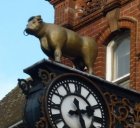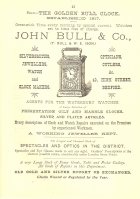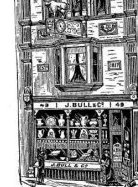Bedford
High Street History
Places > Bedford > Streets > High Street
John Bull - Jewellers and Silversmiths
47-49 High Street
Home | John Bull History | Sources | Images
John Bull History
 In
1825 a stocky little man from Kimbolton named John Bull (1802-1870), son of a
butcher, established a small business as a jeweller and silversmith in Bedford,
having served an apprenticeship from 1817. He later moved his business to 49
High Street, Bedford, in premises which had previously been a butchers (Ram
Yard recalls the days when sheep and cattle were driven down the side passage to
the slaughter house at the back). The original shop had two small mullioned
glass windows and a step leading to the door in the centre. There was living
accommodation above. Trade directory entries for subsequent years indicate that
his firm also embraced gun making, watch and clock making and dealing in
optical instruments.
In
1825 a stocky little man from Kimbolton named John Bull (1802-1870), son of a
butcher, established a small business as a jeweller and silversmith in Bedford,
having served an apprenticeship from 1817. He later moved his business to 49
High Street, Bedford, in premises which had previously been a butchers (Ram
Yard recalls the days when sheep and cattle were driven down the side passage to
the slaughter house at the back). The original shop had two small mullioned
glass windows and a step leading to the door in the centre. There was living
accommodation above. Trade directory entries for subsequent years indicate that
his firm also embraced gun making, watch and clock making and dealing in
optical instruments.
John Bull married a Miss Priestman who bore him four sons and two daughters. John was a humanitarian, as is clear from the way he reacted when two burglars were caught red-handed in his shop. Since burglary was then a capital offence, the two men were condemned to death. But John pleaded for leniency and their sentence was commuted to long terms of imprisonment in Australia. Years later, John received a letter from one of the men, who had since made good and wanted to thank him for his help during the trial.
John Bull eventually moved his family home to Kimbolton Road and could be seen each morning, driving his pony-chaise down the High Street to his shop. He left the transport at the Coach and Horses pub which was opposite the present Corn Exchange, by St Pauls Church.
When he died in 1870 his two sons Richard and Thomas took over the business. They decided to pull down the premises, by now dilapidated, with rats in the living rooms in the basement. In its place they erected the present building with its elaborate brick faade, with large projecting clock and golden bull (a pun on the family name), making one of Bedford High Streets most familiar landmarks. In addition, there was a vertical pole set back behind the clock, which carried a golden ball which could move up and down the pole but was normally set near the top. At 10.00 am each morning, the ball would drop down and strike a large bell. This was the signal for people down the High Street to set their pocket watches, since the device was set off by an electric signal which came directly from Greenwich.
Richard also became Mayor in 1870 and donated the present mayoral gold chain to the town. After Richards sudden death in 1880, Thomas became sole proprietor and lived there above the shop. He too played an active part in the towns civic life, as a JP and a churchwarden at St Pauls Church. It was he who paid for the installation of carillon chimes which used to play tunes using the peal of bells, every hour.
There is an amusing story of how, one night, Thomas was awoken when he heard a noise in the yard below, at the back of the premises. In the dim light he saw a figure apparently trying to get in through the side door. Throwing up the window, Thomas shouted to the intruder to go away or be shot. The man made no attempt to depart and appeared not to have heard, so Thomas fired a shot at the opposite wall. This seemed to have some effect, for the man disappeared. The next morning a detachable collar, with the culprits name on, was discovered in the yard. To the great delight of the many shopkeepers of the High Street, word soon got round that one of their number had been so intoxicated the night before that he was unable to recognise his own house.
Thomas Bull retired in 1899. In 1904, his son-in-law, W.E. Ison, who had taken control of the business, bought the shop next door and enlarged the premises to embrace Nos. 47 & 49 High Street.
During the First World War, the firm became contractors to H.M. Government as makers of time fuses and of turnbuckle (devices for tightened wire on the early aircraft). Around 100 people, mostly girls and discharged soldiers were employed on the various upper floors of the enlarged premises. When Mr Ison died in 1919, that marked the end of the firm as a family business and it was made a limited company, John Bull & Co (Bedford) Ltd, which it still operates as, today, albeit in St Peters Street.
The firm was very much the county jeweller and set a high standard of work. Their staff were known widely for their expertise. After 1918 the firm had one silversmith, two goldsmiths, and 2 or 3 watch and clockmakers in their in-house workshops, in addition to the shop staff. Memorable commissions included an engraved presentation plate for the ill-fated R101 airship, which later crashed in flames over France, and a diamond and platinum brooch presented to the Queen Mother by the Beds & Herts Regiment. In the nineteenth century, the firm had contacts with the large houses in the surrounding countryside to repair and service their clocks. Jewellery repair was done in the firms own workshop, altering a ring or having a gemstone fitted.
Even in the 1920s, there were still superstitious people who would call in with a small medicine bottle and request some gold water, the water which gold was washed in. Some people believed that it had magical properties, a hang-over from medieval belief in alchemy.
One of their memorable post-war customers was a rag and bone man who operated from a horse and cart. He came in twice a year, in the summer and at Christmas to buy his wife something in silver. He always paid cash in loose money.
Eventually, as workmen retired or died, the silversmith and goldsmiths, work started being sent away for repair, out of the shop. The types of watches changed over time, from the traditional winding ones to the automatic and battery-driven digital ones. The 49 High Street premises were sold by auction on 19 February 1964 and in September the firm moved to 21 St Peters Street, Bedford, where it still trades, over 185 years after it began, one of Bedfords oldest firms.
Stuart Antrobus, 2011
Sources
Bedford Local Studies Library and Heritage Library (HL)
- Where to Buy at Bedford, an illustrated local review, 1891 p.48 HL BED/WHE
- Bedford Local Directories HL
Articles
- Bedford Journal
John Bull & Co.- where there's no time like the present 22.9.1976 - Bedford Record
Tribute to the Director. 12.4.1949
Genuine Clock and Bull Story. Bedford Record 22.5.1972
The Bull Returning to the High Street. (Town and Around with the Stroller) 30.4.1974
Town and Around with the Stroller article 7.5.1974 - Bedfordshire Herald
John Bull and Co (Bedford) Ltd. 170 Years of Independence.19.11.1987 (advertisement feature) - Bedfordshire Times
The Golden Bull. 1.8.1958
Old Established Firm to Move. 11.1.1964
Founder of Firm. 28.8.1964 (includes and image of John Bull)
Clock and Bull are Re-gilded. 22.1.1965
Beds Times Octocentenary Supplement 1966
Glitter Rubs Off the Bull. 14.1.1972
The Bull is Back on its Beat. 3.5.1974
A Treasure Trove of Top-class Service. 10.9.1976 (advertisement feature) - Bedford Architectural, Archaeological and Local History Society Newsletter
Antrobus, Stuart. John Bull - Bedfords Oldest Jewellery Firm. 88 October 2011 pp. 19-26. Detailed references are included.
BARS
Documents
- Watch Register of 1865-78
- P68/5/4c (Pavenham) Bill for repairs to clock 1873 [showing business letterhead] X67/806 Billhead, etc. 1877
- SD Ravendsden 4/12 Bill for repairs to clock 1881-82
- P67/2/12 (Bromham) Bill for a memorial brass erected in Bromham church
- X454/72/6 Bill for wedding gift, showing period letter heading, September 1924
- Z955/2/2 Headed letter, 1966
- CRT 160/205 Memorandum of association as a limited company 28.11.1918
- CRT 160/205 History of John Bull & Co. 1817-1921 by Mrs Ison and Mrs Le Mesurier (Ada Bull). This was mainly written, in 1967, by the grand-daughter of the original John Bull to clelebrate the 150th anniversary of the founding of the firm.
Photographs
- Z808/4/2 Photo of shop front in illustrated booklet Picturesque Bedford p.34, c. 1903
- Z983/1 Photo postcard of Bedford High Street, including John Bull & Sons building and numerous horse-drawn vehicles, c1905 [golden Greenwich time ball& its post visible above & behind bull clock]
- BP 48/6/19 Exterior of J. Bull & Cos shop window, showing a Giant Omega watch, 1920
- BP65/52/33 View of J. Bull & Cos bull & clock, taken from an upper window, No. 47 High Street c. 1950s
- BP65/52/34 Close-up view of clock and bull taken from upper window of 47 High Street., c. 1960s
- BP65/52/35 Cut out photo of bull statue above 49 High St. shop, viewed from South West, 1980
The Higgins
- wav2833, 7.10.2009. Notes from an oral history interview by Carmela Semeraro with Richard Stoodley, heir to the John Bull business in Bedford
- wav2809, 8.9.2009. Notes from an oral history interview by Carmela Semeraro with Eric Rainbird, former shop assistant at John Bull Jewellers, Bedford, 1946-1987
Images
Page last updated: 28th May 2020



